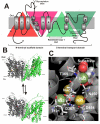SLC1 glutamate transporters
- PMID: 24240778
- PMCID: PMC3896240
- DOI: 10.1007/s00424-013-1397-7
SLC1 glutamate transporters
Abstract
The plasma membrane transporters for the neurotransmitter glutamate belong to the solute carrier 1 family. They are secondary active transporters, taking up glutamate into the cell against a substantial concentration gradient. The driving force for concentrative uptake is provided by the cotransport of Na(+) ions and the countertransport of one K(+) in a step independent of the glutamate translocation step. Due to eletrogenicity of transport, the transmembrane potential can also act as a driving force. Glutamate transporters are expressed in many tissues, but are of particular importance in the brain, where they contribute to the termination of excitatory neurotransmission. Glutamate transporters can also run in reverse, resulting in glutamate release from cells. Due to these important physiological functions, glutamate transporter expression and, therefore, the transport rate, are tightly regulated. This review summarizes recent literature on the functional and biophysical properties, structure-function relationships, regulation, physiological significance, and pharmacology of glutamate transporters. Particular emphasis is on the insight from rapid kinetic and electrophysiological studies, transcriptional regulation of transporter expression, and reverse transport and its importance for pathophysiological glutamate release under ischemic conditions.
Figures




References
-
- Abrahamsen B, Schneider N, Erichsen MN, Huynh TH, Fahlke C, Bunch L, Jensen AA. Allosteric modulation of an excitatory amino acid transporter: the subtype-selective inhibitor UCPH-101 exerts sustained inhibition of EAAT1 through an intramonomeric site in the trimerization domain. J Neurosci. 2013;33(3):1068–1087. doi:33/3/1068 [pii] 10.1523/JNEUROSCI.3396-12.2013. - PMC - PubMed
-
- Adamczyk A, Gause CD, Sattler R, Vidensky S, Rothstein JD, Singer H, Wang T. Genetic and functional studies of a missense variant in a glutamate transporter, SLC1A3, in Tourette syndrome. Psychiatric genetics. 2011;21(2):90–97. doi:10.1097/YPG.0b013e328341a307. - PubMed
-
- Allritz C, Bette S, Figiel M, Engele J. Endothelin-1 reverses the histone deacetylase inhibitor-induced increase in glial glutamate transporter transcription without affecting histone acetylation levels. Neurochem Int. 2009;55(1-3):22–27. doi:10.1016/j.neuint.2008.12.020. - PubMed
-
- Allritz C, Bette S, Figiel M, Engele J. Comparative structural and functional analysis of the GLT-1/EAAT-2 promoter from man and rat. J Neurosci Res. 2010;88(6):1234–1241. doi:10.1002/jnr.22303. - PubMed
Publication types
MeSH terms
Substances
Grants and funding
LinkOut - more resources
Full Text Sources
Other Literature Sources

